News & Community
For the Lost or Missing in Maryland, These Search Dogs Really Are Humankind’s Best Friend
While some might think it's police K9 units that accept the call, it's really volunteer dog lovers with a dedication to service—like those with Chesapeake Search Dogs.
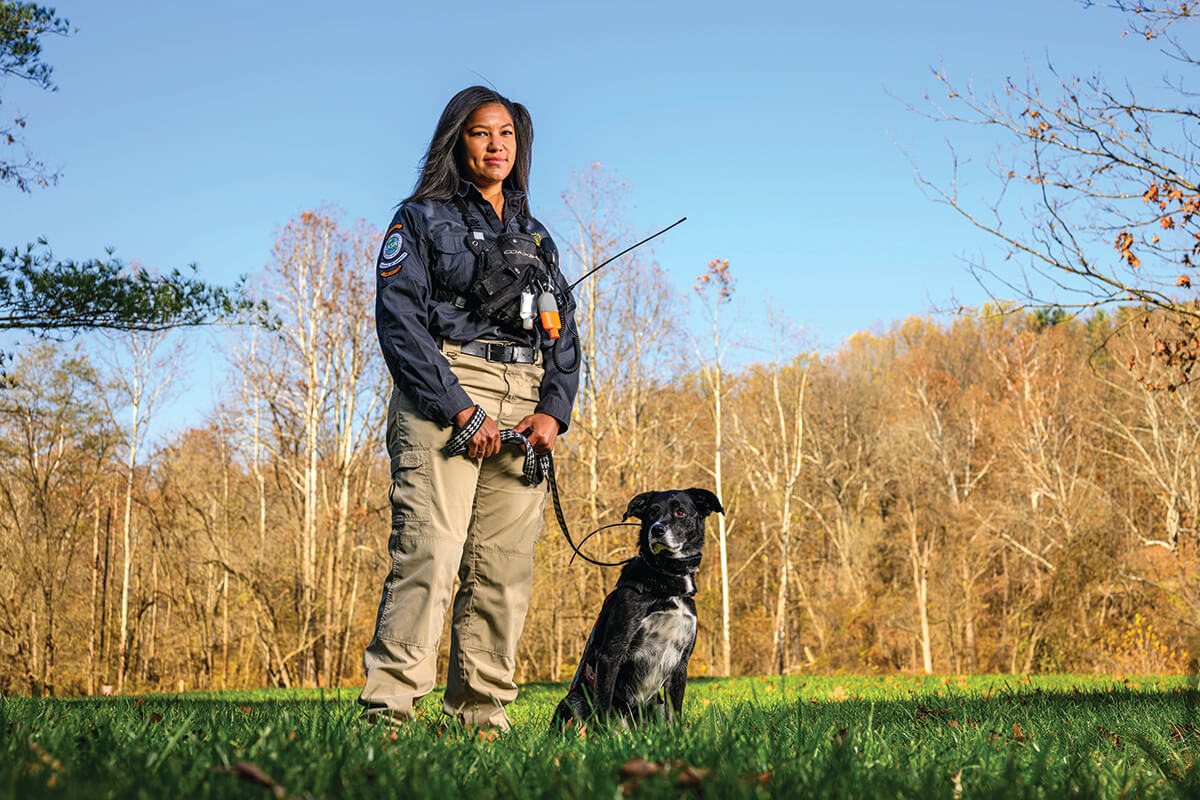
It’s late October and leaves are thick on the ground in Gunpowder Falls State Park in northern Baltimore County. It’s unseasonably warm and a moon, almost full, is rising in the sky. But without a flashlight it is black as pitch in the woods.
“There’s someone out here,” says Sally Robb, leaning down to remove the leash on her eight-year-old border collie mix, Watson. “Go find.”
At her command, Watson streaks into the woods. He wears a GPS tracker and a light-up collar that flashes green as he ranges in and out of trees, a bell on his vest ringing his whereabouts. Dropping deeper into the park, cooler air signifies we’re nearing the Gunpowder River. Robb, 37, takes in Watson’s behaviors down to the most subtle tail twitch. She knows this dog nearly as well as she knows herself.
“There,” she says, “did you see his head pop?”
Almost imperceptibly, Watson has filtered out the millions of scents that are in the park and picked up the one he’s here to find: human. Later, he races back to Robb, jumps on her chest, and bolts away. This is his trained final response move, an indication for her to follow.
She does just that as the dog continues to run back and forth, jumping on her chest and returning to his find—in this case, fellow search dog handler Sue King, who is curled in a patch of grass at the foot of a tree along the riverbank. Having done his work, Watson receives his reward, a red Wubba toy with waving arms like an octopus, and he, Robb, and King enjoy a joyful and intense game of tug.
This is only a training exercise. Had this been an actual search for a missing person, Robb and Watson may have been out for much longer, searching a sector mapped out by law enforcement that could be 25, 40, or even 80 acres. So, two nights a week and some Saturdays, Robb, executive director of the nonprofit Chesapeake Search Dogs (CSD), meets with fellow search and rescue (SAR) canines and their human handlers to keep their skills sharp in both live and human-remain detection (HRD).
“Mostly people think police do this work,” says Robb. But even if local law enforcement has a K9 unit, they are rarely trained in SAR or HRD.
Chesapeake Search Dogs was actually founded by members of the Baltimore County Fire Department when it disbanded its in-house SAR unit in 1997. Given the time and money it takes to train these skilled canines, the all-volunteer nonprofit model makes sense.
It can take up to two years to train a dog, which needs at least 2,000 hours of training to be National Association of Search and Rescue certified. And when you factor in the gear, training, and certifications, it adds up to more than $3,000 a year.
Human handlers have an even larger learning curve. You first learn to be a flanker, someone who assists at searches with everything from navigation (with map and compass—you can’t rely on a cell signal) to radio communication. Handlers must be wilderness first aid certified, know basic canine first aid, and be knowledgeable of the most minute air movements that can mean the difference between a dog picking up the scent of its quarry—or blazing right by it.
Robb, chief of staff for Maryland Senate President Bill Ferguson by day, got into this work after watching a documentary about 9/11 that mentioned SAR volunteers. It was the first time she realized the work was not done by police but rather people like her—dog lovers with a dedication to service. And when she adopted Watson, then 11 weeks old, from a rescue in 2015, he was a smart, driven, high-energy dog. In other words, a dog desperately in need of a job.
“You want to lean into the natural tendencies of the dog, their natural drive for chasing prey, so you want dogs that have long noses and have a really high play drive or food drive, because ultimately, they’re doing the work for a ‘paycheck,’” says Robb.
The paycheck is the special toy, like Watson’s Wubba. To work long hours in all terrain, dogs also need size and stamina, so breeds like German shepherds, Labradors, golden retrievers, border collies, and some spaniels are naturally suited to the work.
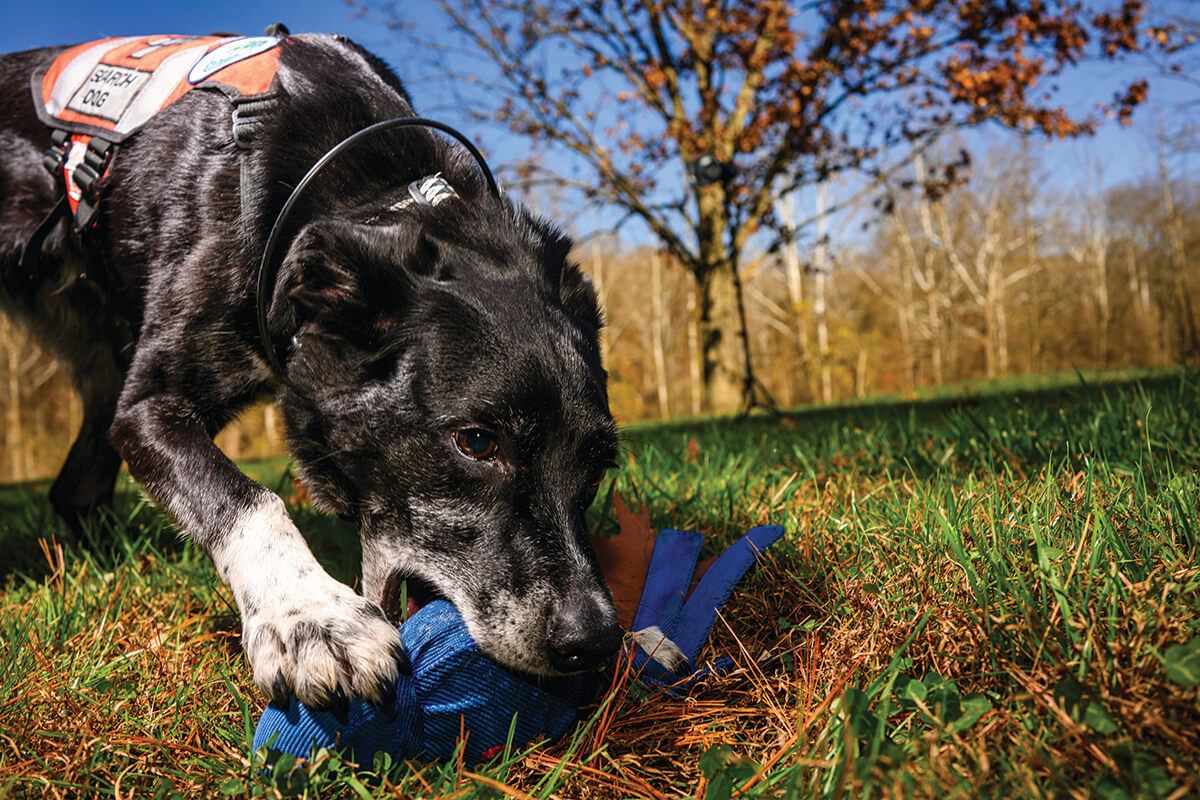
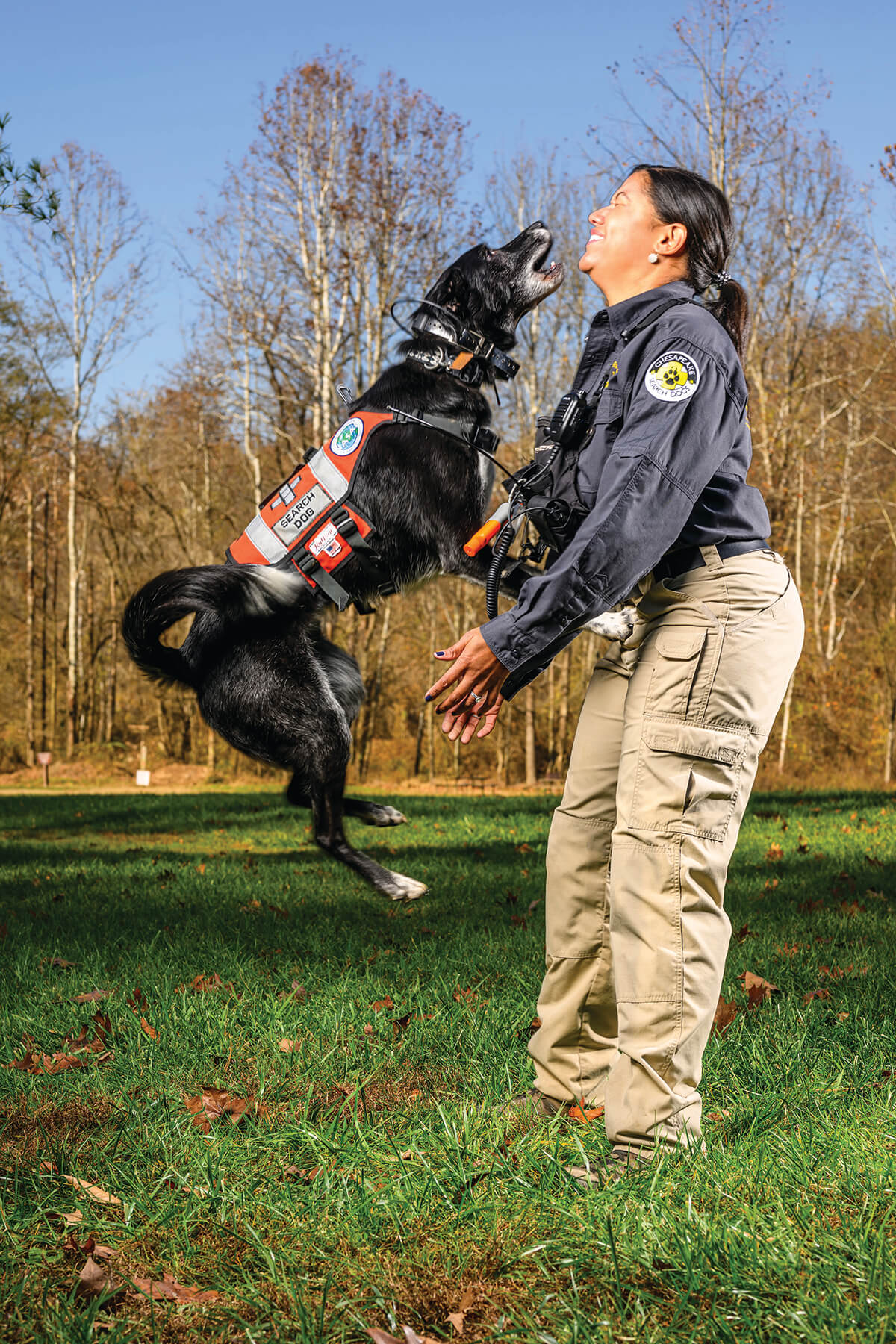
The canine nose is both a finely tuned instrument and a wonder of engineering. Dogs possess up to 300 million olfactory receptors in their noses, versus about six million in humans. Not only is the area of their brain dedicated to analyzing smells 40 to 100 times greater than ours, when dogs inhale, a fold of tissue just inside their nostril helps to separate the functions of breathing and smelling, allowing a dog to smell even when it exhales. They can also smell different scents in each nostril.
With this extraordinary snout, a dog can find people buried in rubble and underwater, human remains as old as 200 years, and something
as small as a single drop of blood in an area equivalent to an Olympic-size swimming pool. One dog can search for a person in an hour with greater effectiveness than 120 people.
Chesapeake Search Dogs exists to be a tool for law enforcement and fire services search managers. They accept calls only from local, state, or federal law enforcement via a 24/7 hotline, at which point the number of resources and types of dogs needed are determined. CSD’s services are provided for free anywhere in Maryland, Delaware, northern Virginia, and southern Pennsylvania. Currently, they have 13 handlers, 15-plus dogs, and a pipeline with pups in training. They conduct about 40 searches annually.
When Watson returns to Robb’s jeep, he hops in next to his new “brother,” a golden retriever puppy named Seagram Van der Robb who is there that evening to adjust to spending time alone in the truck. In this game of hide-and-seek, it is Robb’s turn to play lost hiker. King gets her 10-year-old Labrador, Jax, from his crate in her car.
When law enforcement reaches out, it is often for a situation like tonight’s role play: A lost hunter or an elderly person, child, or vulnerable adult has managed to slip away from caregivers and needs to be located. These are the calls that usually come late at night, when someone didn’t turn up at dinner, perhaps, and family have already looked for the person on their own. This is wilderness air scenting, more commonly called “live find.”
“More often than not, we tell the police there’s no one in an area and they can redirect their search,” says Robb. “That’s the stressful part, telling police with confidence that an area is clear, because they might re-search the area, but generally they’re going to say, ‘Great, we trust you. We’re moving over here.’”
ONE DOG CAN SEARCH FOR A PERSON IN AN HOUR WITH GREATER EFFECTIVENESS THAN 120 PEOPLE.
Search dogs operate based on commands from their handler. When their leash is removed, they go into hunting mode. There’s no cinematic waving of a piece of the missing person’s clothing under their nose. King gives Jax his command and he trots off at a more leisurely pace than Watson. The dog knows what he is there to find. Jax has already sniffed the people he came into the woods with—humans, but not the one he’s looking for. As he zigzags through the underbrush, he enjoys plenty of sniffing (the pee of other dogs, deer, and squirrels). All interesting, no doubt, but not his missing person. That’s the only thing that will earn him his beloved tug toy.
“For wilderness live finds you’re looking for any living person in an area,” Robb explains. “[Dogs] learn to scent discriminate,” she continues. “They will come up and what we call ‘scent check’ someone…they’re kind of thinking, ‘Am I smelling people that are just with me and I can ignore or am I smelling someone entirely new, and that’s the person I need to find?’”
Of course, even a live find can turn tragic—the lost can die of exposure, or in an accident, for example. Handlers grapple with that reality early in training.
“You stay focused on the task at hand and think, ‘I need to be proficient, professional, and provide these services so that law enforcement can do their job and their broader public service,’” says Robb.
Human remains detection, what many know better as “cadaver dogs,” is a more diverse discipline covering evidence searches, suicides—even drownings. Given a patient captain, a canine in a boat can locate submerged human remains. One of the handlers recalls how her German shepherd, Tank, once located a suicide victim in 14 feet of water.
Training a cadaver dog is a more nuanced discipline because there are a greater variety of odors present and more variables. Remains might be up a tree, buried, or years old.
It is a best practice for HRD handlers to train their dogs at one of the country’s eight “body farms,” forensic research facilities for the study of human decomposition. The most recent—and now nearest—farm opened last year at George Mason University in Virginia. Unlike in live find, canines searching for human remains don’t wear vests and bells. These searches are often scheduled and conducted in daylight by law enforcement who know what they’re looking for in a specific area. To keep HRD skills honed at their weekly trainings in the local park, CSD ethically procures “source” (i.e. blood, tissue, bone) from reputable organizations.
At the evening training in the park, the source is a piece of cloth with blood on it. It’s about two years old. A handler places it in the woods while King retrieves her husband Jay’s red Labrador, Pyro. King gives her command, “Search,” and the dog is off.
While a live find dog repeatedly runs from the found person to the handler, most HRD dogs either sit and stay with the remains or sit and bark. Another handler at the training explains this is because the find can be as small as a tooth or a drop of blood; once located, the dog needs to stay with this tiny piece of evidence. And if remains are buried in rubble, for example, it would be difficult for the dog to move back and forth.
Within minutes Pyro has approached an old log and starts dancing on all four paws before she sits and barks insistently. She’s found the cloth and receives her toy. Her job, this game of hide-and-seek, is complete. Not surprisingly, the bond between dog and handler is strong.
“The relationship between the canine and the handler is very close because it is fundamentally based on trust,” Robb explains. “You’re reading their behavior and they’re reading yours. If you’re stressed, the dog is like, ‘Mom’s really anxious.’ And that can make a dog shut down.”
The people who do this work form a tight-knit community, too.
“I’ve met a lot of different people in a lot of different walks of life, but the search and rescue community are so selfless,” says Robb. “They volunteer their time and spend their money just to make sure their dogs are proficient and can locate people. The people are incredible, as are the abilities of the dogs. This becomes a part of your life.”
Robb met her husband, Nate, through SAR. Sadly, his dog, Fitzgerald, died last year, but Seagram the puppy is already bonded to his new dad. At home in South Baltimore, Watson and Seagram live like typical pets with their cat pal, Farnsworth, though you may not find them frolicking with other pups in the dog park.
“They’re like a $100,000 sports car,” says Robb. “I can’t afford to have anything go wrong. I need him as my partner.”
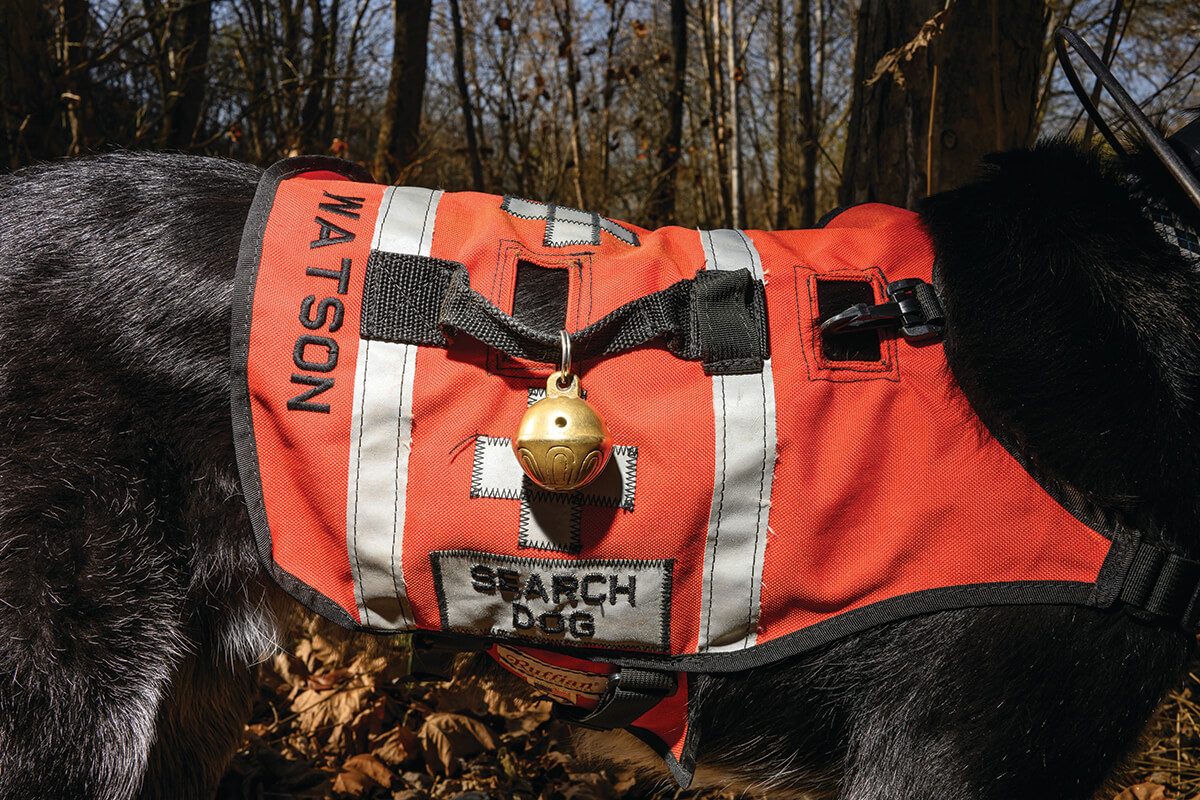
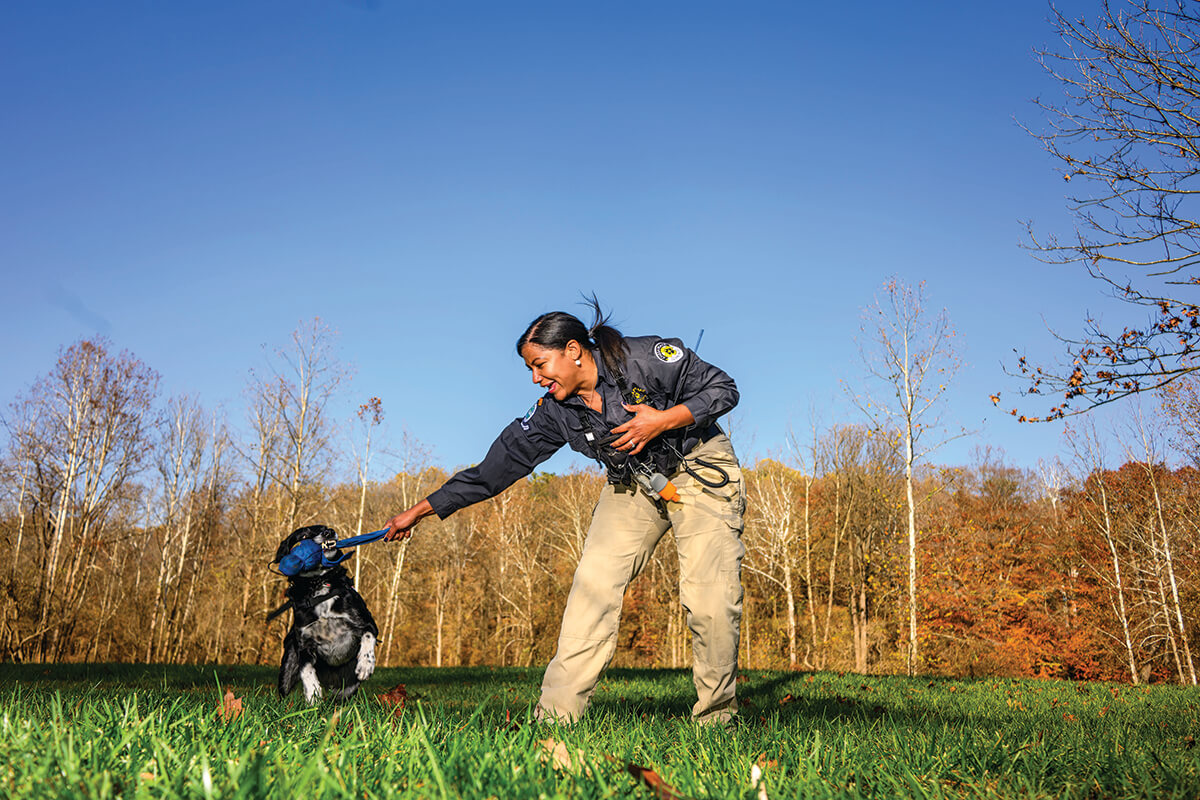
The moon is high in the sky when training winds down. A few stragglers chat in the silvery moonlight that fills the parking lot as dogs’ light-up collars are removed and they are put into their crates or backseats for the ride home. A great horned owl hoots deep in the woods. Robb brings out Seagram, who has patiently spent the night in the car. Though only a few months old, he can already sit and stay and is being trained on his special toy, building his play drive. Based on his yaps when he was left out of the evening’s fun, Seagram is well on his way to being a great sit-bark dog.
Conversation turns to most memorable finds. While it can be satisfying to clear an area, it’s a heavy responsibility, too, and the days you don’t find what you’ve been sent out for can be haunting. But the best moments, says Robb, are when you find the person you’re looking for alive and well. Maybe it’s a child who ran off, or a grandparent with dementia who wandered away in nothing but pajamas on a frigid night.
“Frequently, there’s a family member who’s in close proximity to you; the stakes are high, seeing the angst of a family member looking to us,” Robb says. “That’s the reason why we all invest so much into this, because, regardless of the situation, this is someone’s loved one.
“When you find a person and the dog does their trained final response—there’s nothing like that moment.”